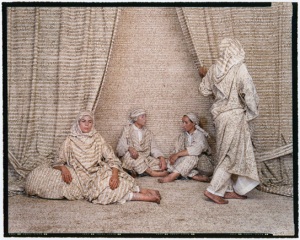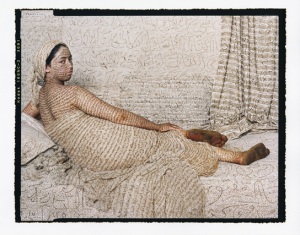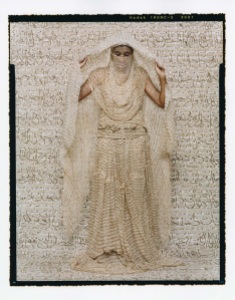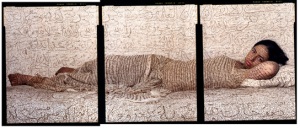Lalla Essaydi’s Les Femmes du Maroc is a must-see. Today is its last day at the DeCordova Museum, in Lincoln, MA, but it will be soon travelling to the Jane Voorhees Zimmerli Art Museum in Rutgers, New Jersey.
In her large-format photos of women in chadors, and, sometimes veils, Moroccan- born Lalla Essaydi presents a beautiful and provocative challenge to perceptions about Muslim women going back centuries.
The limited palette photographs in henna, black, and gray on white, depict individual or groups of women in chadors and, sometimes, veils, in poses or situations modeled after paintings by great European masters, reproductions of which accompany most of the photos. 
But instead of emulating the rich color and sexual innuendo of the paintings, Essaydi changes gestures, replaces men with women, and covers much of the surface area with arabic writing–illegible even to those who know the language.
As described on the DeCordova Web site, These women inhabit a place that is literally and entirely circumscribed by text, written directly on their bodies, apparel, and their surroundings by the artist herself.
 In commentary provided through cell-phone dial in (difficult to hear because Lincoln has limited cell service) Essadi explains that she wants to make clear that the work of male artists of centuries past has done a disservice to Muslim women by objectifying them as sexual objects, often in harems.
In commentary provided through cell-phone dial in (difficult to hear because Lincoln has limited cell service) Essadi explains that she wants to make clear that the work of male artists of centuries past has done a disservice to Muslim women by objectifying them as sexual objects, often in harems.
She points out that writing was a form reserved for men, and that one of the original painting is so extraordinarily beautiful that one can easily overlook the subject matter: a naked woman being sold as a slave.
She brings up the difference between private and public space–that painters would never have been allowed into women’s homes, which were considered private space–but thought nothing of bringing women into their studios and showing paintings of them in public spaces–which were ordinarily reserved for men.
 Essadyi also provides a complex interpretation of “the veil”. On the one hand, its use is sometimes considered a way of subjugating women, of keeping them out of public life, of denying them equality, full citizenship. On the other hand, she says, she herself sometimes appreciates the veil and finds it freeing–because it protects her and her privacy from a potentially dangerous outside world.
Essadyi also provides a complex interpretation of “the veil”. On the one hand, its use is sometimes considered a way of subjugating women, of keeping them out of public life, of denying them equality, full citizenship. On the other hand, she says, she herself sometimes appreciates the veil and finds it freeing–because it protects her and her privacy from a potentially dangerous outside world.
Organized by Senior Curator Nick Capasso, Les Femmes du Maroc will travel to the Jane Voorhees Zimmerli Art Museum, Rutgers, The State University of New Jersey, January 30, 2010 – June 6, 2010.
——-Anita M. Harris
New Cambridge Observer is a publication of the Harris Communications Group of Cambridge, MA. We also publish Harriscomblog and Ithaca Diaries blog.




